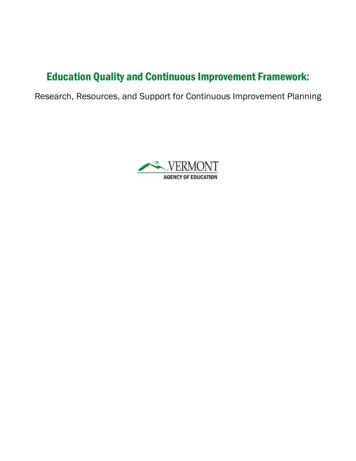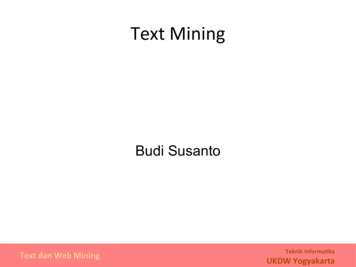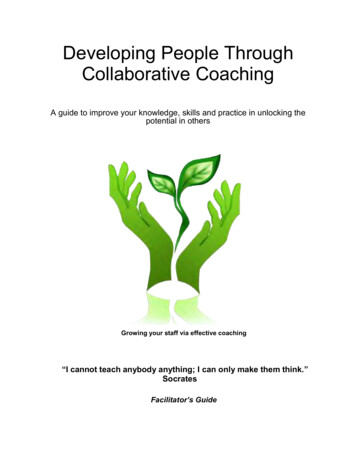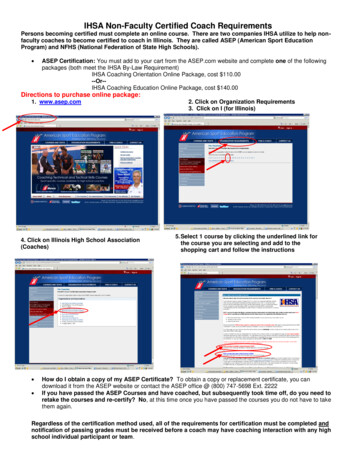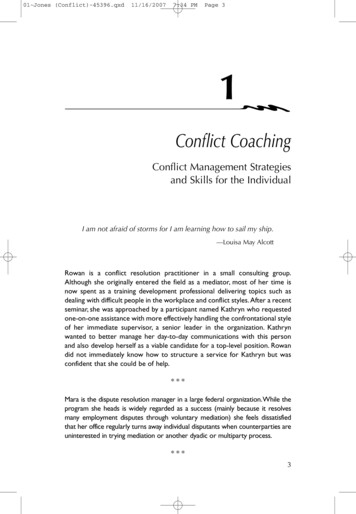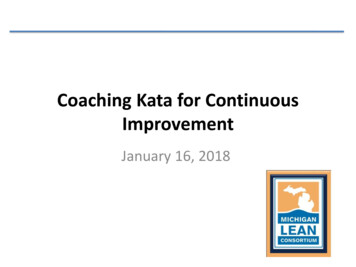
Transcription
Coaching Kata for ContinuousImprovementJanuary 16, 2018
30MinutesLet’s GetAcquainted
Kata Coaching Agenda Lean Leadership in the Pursuit of ExcellenceCoaching for CommitmentKaizen/Kata Improvement ProcessKATA Mindsets for Continuous LearningCoaching Kata for Daily ImprovementCreating Habits of Scientific ThinkingCoaching for Developing Leaders/AssessmentsHave Fun Learning Together 2017 LeanWork LLC3
Tennis Ball Exercise1.2.3.4.5.Rules of EngagementMust begin and end with meEveryone must touch the ballRemember the process sequenceDebrief10Minutes
What are We Trying to Achieve?10MinutesExcellence!
TrendsOutside Environment– Customer expectations are rising– Intense competition– Methods are being challenged– Employee Engagement is lowWe Must:– Commit to Excellence– Do things right the first time and every time– Take cost and waste out of our processes and systems– Use our knowledge and experience 2017 LeanWork LLC6
In Pursuit of ExcellenceExcellence Has No Boundaries 20172017 LeanWorkLeanWork LLCLLC7
At the Center of Excellence?HowWhatWhy 2017 LeanWork LLC8
Operational ExcellenceA strategy mindset of leadership, teamwork, and employeeengagement resulting in extraordinary performance byfocusing on customer needs, standardizing processes andcontinuous improvement to optimize effectiveness. 2017 LeanWork LLC9
Elements of ExcellenceExceptionalVa l u e C r e a t i o nL TEACOOLN SULTURE 2017 LeanWork LLC10
Breakout Session Take 3 Minutes Individually? Break into two groups – 12 Minutes Discuss and Develop a Master List? 2017 LeanWork LLC11
Barriers to ues 2017 LeanWork LLC12
StandardizedProcessesKPI’sCynicismValues answers the questions: What is it like to work around here? What gets recognized and rewarded? 2017 LeanWork LLC13
Coaching Engagement StrategyHighLearningLowHighLow 2017 LeanWork LLC15
Organizational AlignmentVision & PurposeValuesOperationalStrategyGrowth StrategyKey InitiativesKPI’sKey InitiativesCI StrategyExecution PlanKPI’sCI StrategyExecution Plan 2017 LeanWork LLC16
Tennis Ball Exercise – Round 210Minutes
Art of Coaching
Breakout Of Your Comfort Zone Break into groups of Two Select a Learner and a Coach Improve your Juggling Skills 2017 LeanWork LLC19
What Do We Need?
Coaching ModelT TopicG GoalO OutcomeR RealityO OptionsW Way Forward21
Coaching WorksheetTopicGoalOutcomeRealityOptionsWay Forward22
Round 2 - Breakout Of Your Comfort Zone Break into groups of Two Select a Learner and a Coach Use Coaching Model Worksheet Improve your Juggling Skills 2017 LeanWork LLC23
Forming a HabitT TriggerR Creates a RoutineR Receives a RewardR Repeated with same ResultHabits provide routines patterns of thoughtthat allows our brains to be on auto-pilot 2017 LeanWork LLC24
Coaching Tips Leave your ego at the doorEgo and Modesty Ask questionsEGOHigh Listen for Clueslll Fact based Thinkingll Let the data drive LeadershipHigh Commit to learning togetherlll Value each penness—ListeningAdmits cePower-hungerSelfishness“Taker”Poor listening Have a Mindset of customer service Be committed to their successCoaching Focuses on Learning and Developing Patterns ofBehavior 2017 LeanWork LLC25
Round 3 - Breakout Of Your Comfort Zone Break into groups of Two Select a Learner and a Coach Use Coaching Model Worksheet Improve your Juggling Skills 2017 LeanWork LLC26
Coaching for Continuous Improvement Identify specific continuous improvement process strategies Pattern of thinking and mindsets Developing new patterns of behaviorIt takes 21 days to build a habit 2017 LeanWork LLC27
Improvement StrategyKaizen Focuses on the Known IssuesLean tools and techniques to improvequality, cost, delivery and 5SKata Focuses on the UnknownA daily routine of scientifically thinkingand experimentingSupervisors become Leaders and Coaches ofthe Improvement Process 2017 LeanWork LLC28
CI Improvement Overviewxxxxxxxxxxxxxx xx x x x x xxx xxxxxxxxxxxxxxxxxXKnownobstacles?Unknown obstaclesTC1TC2TC3ChallengeVisionRole of LeadershipThreshold of KnowledgeTarget ConditionsCurrent Stateof Operation29
Decision MatrixHighKataPDCA CyclesKaizenJust do itDon’t Do’sGo SeeLowHighLow 2017 LeanWork LLC30
Kaizen StrategyKaizen Focuses on the Known IssuesLean methods to improve: Safety Quality Delivery Productivity Customer SatisfactionReady –Aim - Fire 2017 LeanWork LLC31
Kaizen Team Defined Goals and ScopeCross Functional TeamAssigned Team LeaderSpecific Time Frame5 to 7 is an Optimal SizeCombination of Training andDoingFacilitated Sense of UrgencyImplement SolutionsDocumented Report Out 2017 LeanWork LLC32
What is Kata?Kata are structured practice routinesKata involves the invisible art ofthinking and patterns of behaviorwhich form habits.A daily routine of scientifically thinking,experimenting and learning 2017 LeanWork LLC33
Kata EffectDevelops patterns of learning that increase ateams ability to: Engage in true Problem Solving Over come barriers Share Information Take Responsibility Gain Common CommitmentLean Leader’s become Coaches of theImprovement Process 2017 LeanWork LLC34
KATA StrategyKata Focuses on the Unknown Issues Combines analytical thinking Structured repeatable routinesPracticeLearning Transforms habits Develops problem solving skillsExperimentingEffectiveness Thinking x Behavior 2017 LeanWork LLC35
Scientific ThinkingIs the Means to:Be data drivenTake logical steps toward the target conditionUnderstand key areas of process variationProvide a systematic method to change behaviorAllow decision to be made at point of useSupport learning to think differently through experimentation 2017 LeanWork LLC36
Can you read this?Please read aloud what you seeCa y u rea t is 2017 LeanWork LLC37
Can you read this?Please read aloud what you seeLUMPING TO CONCLUSIONS 2017 LeanWork LLC38
AssumptionsPlease read aloud what you seeLUMPING TO CONCLUSIONS 2017 LeanWork LLC39
Coaching Improvement StructureVision & PurposeLearnerLearnerLearnerLearnerCoachCoach2nd Coach 2017 LeanWork LLC40
Kata Process Improvement Routine: Identify a Challenge Understand the Current Condition Identify the Focus Process Establish a Target Condition Measure the Actual Condition Identify the Obstacles Conduct a PDCA Repeat the Process 2017 LeanWork LLC41
Kata Improvement BoardFocus ProcessTC#1Challenge StatementAchieve byTarget ConditionBlock DiagramImprovement StepsCoaching CycleDate/ActionsProcess CharacteristicsDetailed StepsProcess MetricsOutcome MetricsMeasurementsExpectationsWhat do youexpect to happen?PDCA CyclesExperimental CycleWhat did weWhat Happens?learn?Facts and DataImpact?ProcessWhat do youexpect to learn?ObstacleHow will it impactyour next PDCAcycle?Does it build fromother PDCA’sCurrent ConditionAbout the problem?TimingBlock DiagramProcess CharacteristicsBrainstorm Improvement ListTrack KPI'sNegative ImpactFact basedProcess MetricsOutcome MetricsObstaclesTrack KPI's 2017 LeanWork LLC42
Challenge Statement Compelling & Impactful: Stretch Team Focused Achievable Time Based Reviewed Celebrated Provide Organizational AlignmentIt would be AWESOME if by August 2018 the MLC had50 organizational members actively involved with leanprinciples across the state of Michigan. 2017 LeanWork LLC43
Current Condition Understanding Current State: Block Diagram or Value Stream the Process Identify Pain Points Area of Waste Workplace Organization Collect & Analyze Data Identify the Focus Process Measure the Actual Condition 2017 LeanWork LLC44
Focus Process Highlights a Process Step forImprovement: Identifies ImprovementScope Provides Team Focus High Potential forImprovement and Impact Sets up area forExperiments and Leaning 2017 LeanWork LLC45
Target Condition Milestone toward Challenge: Gap from Current State toTarget ConditionScrap % Provides Direction Sets targets for PDCACycle Must be Time Based Maximum of 50%improvement per targetcondition 2017 LeanWork LLCPerformance Challenge46
Obstacles List of Barriers: Fact based Negative impact on TC Measurable Defines the problemstatement Leads to Cause andEffect Relationships 2017 LeanWork LLC47
Obstacle AnalysisPeopleInformationImprovement ActionsStandardizationMethod 2017 LeanWork LLC48
Three Types of PDCA CyclesGo and See – Direct Observation Data Collection Learn more about the processExploratory Experiments Introducing a change to the process Need to observe to understand effectTesting a Hypothesis Implementing a single change to a processfactor with a prediction of expected results 2017 LeanWork LLC49
Coaching Questions for Daily ReviewWhat is your challenge condition? What is the target condition?Define current state and area of focus? What is the actual condition now? What process step are you going to focus on now?What is your target condition? What is your target condition?Identify Obstacles What obstacles do you think are preventing you from reaching the targetcondition? Which one are you addressing now?Determine next steps and timing What is your next step? What do you expect? How soon can we find out what we have learned from taking that step? 2017 LeanWork LLC50
Coach & Learner PDCA CycleCoach - What did you plan as your last step? Learner describes last step.Coach - What did you expect to happen? Learner reviews expected results.What actually happened? Learner explains what happened with data.What did you learn? Learner summarizes what was learned during the PDCA process.What is your next step? Leaner states what actions are going to be taken next with appliedlearning. 2017 LeanWork LLC51
Kata Coaching ModelImprovementChallengeTarget ConditionTarget ConditionCurrent ConditionTime 2017 LeanWork LLC52
Kata Team Structure Cross Functional Team Learner Team Members First Coach3-5 team membersStand up meetingDocumented PDCA CyclesFacilitated Sense of Learning 2017 LeanWork LLC53
Role of the Learner Establish daily Kata TeamHuddles Document team activities Kata Board PDCA Cycle Form Obstacle List Plan an improvementeverydayProblemSolvers 2017 LeanWork LLC54
Role of First Coach Attends daily Kata Team Huddles Monitor Learner’s progress on KataBoard Ask Questions related to the challenge Observes team and provides feedback Listens more than they talk Cares about learners progress See their role as a process to develop thelearner’s abilities and build trust. Establish milestones for teamcelebrations Re-evaluate the project when the targetcondition is met Establish a new target condition 2017 LeanWork LLC55
Role of Second Coach Attends daily Kata Team Huddlesweekly Challenges Mindsets Stretches thinking out of comfortzone Moving experimenting fromcomfort zone to learning zone Provides an Adaptive Mindset Provides bases for improvingScientific Thinking Observes Team and First Coach Provides First Coach Feedbackand takes responsibility for theirdevelopment. Creates a culture of engagement 2017 LeanWork LLC56
Dreyfus Model of Acquiring Skills
The Coaching Cycle on43ExperimentNextStepObstacleBased on a diagram by Don Clarkhttp://nwlink.com/ donclark/leader/leader.html 2017 LeanWork LLC58
Kata Improvement BoardFocus ProcessTC#1Challenge StatementAchieve byTarget ConditionBlock DiagramImprovement StepsCoaching CycleDate/ActionsProcess CharacteristicsDetailed StepsProcess MetricsOutcome MetricsMeasurementsExpectationsWhat do youexpect to happen?PDCA CyclesExperimental CycleWhat did weWhat Happens?learn?Facts and DataImpact?ProcessWhat do youexpect to learn?ObstacleHow will it impactyour next PDCAcycle?Does it build fromother PDCA’sCurrent ConditionAbout the problem?TimingBlock DiagramProcess CharacteristicsTrack KPI'sNegative ImpactFact basedProcess MetricsOutcome MetricsObstaclesTrack KPI's 2017 LeanWork LLC59
Kata Improvement BoardFocus ProcessTC#1Challenge StatementAchieve byTarget ConditionImprovement StepsCoaching CycleDate/ActionsExpectationsPDCA CyclesExperimental CycleWhat did weWhat Happens?learn?Current ConditionTrack KPI's 2017 LeanWork LLCObstacles60
Key BehaviorsAlways PDCAs, Target Conditions read like a story.Outcomes and implications detailed.Data complete and organized.Knowledge of process details and KATA evident.KEYBEHAVIORSKEYBEHAVIORSNeverAlways Learner is truly iterating towards the target condition alonga path defined by the obstacles. Learning and subsequent action take place as a naturalresult of the outcomes of the PDCAs.KEYBEHAVIORSKEYBEHAVIORSNeverNever All PDCAs and actions are carefully designed to clear thepath to TC and Challenge. Metrics are continuously monitored to ensure that progressis made towards TC and Challenge.KEYBEHAVIORSKEYBEHAVIORSAlwaysAlways Hypotheses and assumptions only based on clear data. Progression from “Go See” to “Experimental” to“Hypothesis” PDCAs evident through data.KEYBEHAVIORSKEYBEHAVIORSNever
Characteristics: Patterns of BehaviorLearn to recognize specific behaviors that contribute to a thy:Attention to Detail:Pattern of BehaviorCoaching Plan20Minutes
Characteristics: Patterns of BehaviorLearn to recognize specific behaviors that contribute to a characteristic.CharacteristicPattern of BehaviorCoaching Plan
Coaching Cycle Observation Q2Q3Q4Q564
Coaching - Do’s and Don’ts Schedule Regular coaching cycles Conduct infrequently coachingcycles Establish meeting agenda Keep learner focused on process Ask questions to uncover theunknown Permit unstructured anddisorganized discussions Focus on the coach’spreconceived ideas 2017 LeanWork LLC65
Leadership’s Role in Kata Implementation Provide Resources Coach, Learner & Team Members – 3 to 5 Total Second Coach Leadership Role Set Challenge Understand Kata Process Communicate the “Why” Review learning, results and support team activities Attend team meetings at scheduled times 2017 LeanWork LLC66
In ConclusionRelentlessPursuit of EngagementStandardizedProcesses 2017 LeanWork LLCKPI’sExcellence67
ReferencesSpecial Thanks Too:Anthony WebsterBrandon Brown:Continuous CoachingCommitment 2017 LeanWork LLC68
W Way Forward 21. Coaching Worksheet Topic Goal Outcome Reality Options Way Forward 22. . Kaizen Focuses on the Known Issues Kata Focuses on the Unknown Lean tools and techniques to improve quality, cost, delivery and 5S A daily routine of scientifically thinking and experimenting

